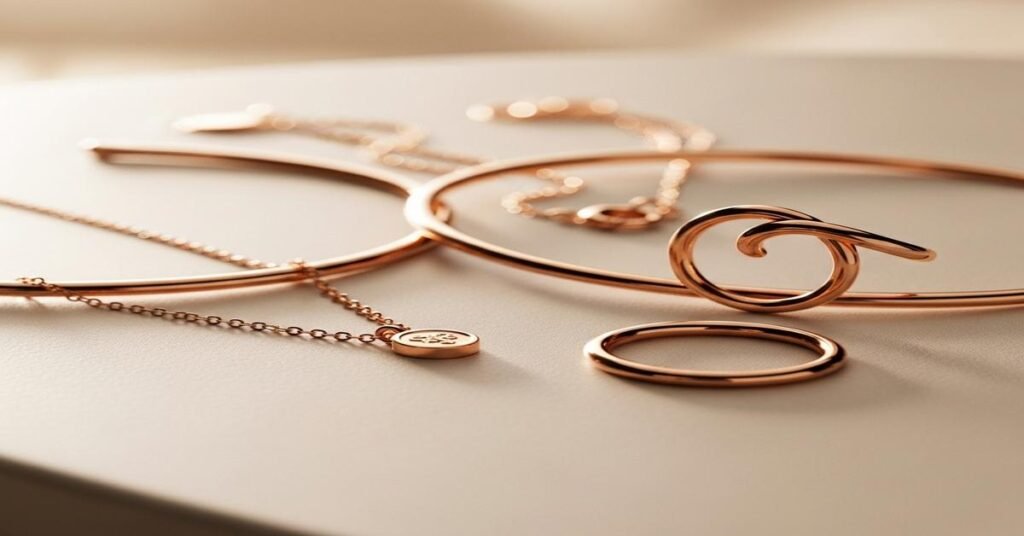Rose gold is one of the fastest-growing metal choices in jewelry. It shows up in engagement rings, wedding bands, watches, and fashion pieces. The color is warm and flattering. But what exactly is rose gold, how is it made, and why has it become so popular? This guide explains the chemistry, the practical differences between grades, care and repair issues, and how to choose the right rose-gold piece.
What is rose gold?
Rose gold is not a separate metal. It is an alloy of pure gold mixed with copper and sometimes silver or zinc. Pure gold (24 karat) is too soft for most jewelry. Alloying adds strength and changes the color.
Common formulas vary by karat. Two standard examples:
- 18k rose gold: ~75% gold, ~22–23% copper, ~2–3% silver. This keeps a warm pink hue while retaining high gold content.
- 14k rose gold: ~58.3% gold, ~38–41% copper, ~1–3% silver/zinc. Higher copper content makes the color redder and the alloy harder.
Manufacturers adjust those amounts to get paler or deeper pinks. Names like “pink gold,” “red gold,” or historical “Russian gold” reflect those variations.
Why does rose gold look pink?
Copper is the key. Copper atoms absorb some blue-green light and reflect red-yellow wavelengths. The more copper present, the redder the metal appears. Silver or zinc are used in small amounts to soften the color and improve workability. Higher karat levels (18k vs 14k) mean more gold and less copper, so 18k rose looks slightly warmer and less intense than 14k rose.
Color examples:
- Pale rose: lower copper, higher silver—subtle pink, often for delicate settings.
- Classic rose: balanced copper and silver—what most jewelry sellers label “rose gold.”
- Red gold: high copper—deep pink or reddish tone, often seen in vintage or Russian-style pieces.
Types of rose-gold jewelry: solid vs plated
There are three common ways you’ll find the look of rose gold:
- Solid rose gold: The entire piece is the alloy (14k or 18k). Color won’t wear off. Repairs must use matching alloy to avoid visible color differences.
- Rose gold vermeil: Sterling silver base plated with rose-gold (must be at least 2.5 microns thick to be true vermeil). Less expensive, but plating can wear where there’s friction.
- Rose gold plated / gold-filled: Thin layer of rose gold over base metal. Gold-filled items have a much thicker layer than electroplated pieces and last longer. Plating will eventually rub off with daily wear.
Durability, allergies, and practical issues
Alloying with copper increases hardness. That means a 14k rose-gold ring is usually more scratch-resistant than an 18k yellow-gold ring of the same design. Why this matters: everyday wear—rings, bracelets, and watches—benefit from the extra strength.
However, copper can cause skin reactions in sensitive people. Most rose-gold alloys are nickel-free, because copper and silver are used instead of nickel. Still, if you have known metal allergies, ask for the exact alloy composition or choose higher-karat solid gold where possible.
Repairs and resizing present another practical concern. Jewelers must use matching rose-gold solder to keep color consistent. If you resize a ring with a poorly matched alloy, the join can show as a different shade.
Care and cleaning
Rose gold is low-maintenance but not maintenance-free. Basic tips:
- Clean in warm water with mild soap and a soft brush. Rinse and dry thoroughly.
- Avoid chlorine and strong acids. Chlorinated pools and cleaning agents can damage the alloy and attached stones.
- Ultrasonic cleaners are usually safe for plain metal, but check gemstones first. Porous stones or certain treatments can be damaged.
- Polish lightly to remove surface scratches. Re-plating or re-polishing can refresh color if plating has worn.
Why rose gold is so trendy
Several practical and cultural reasons drive its popularity:
- Flattering color: The warm pink tones suit many skin tones. The metal tends to make diamonds look slightly warmer and softer, which many buyers prefer.
- Versatility: Rose gold pairs well with white gold, yellow gold, and platinum. That makes mixed-metal looks easy and modern.
- Gemstone pairing: Warm gems like morganite, peach sapphires, and rubies look natural with rose gold. Even green stones (emerald, tourmaline) create a pleasing contrast because green and pink are complementary.
- Design trends: Vintage and Art Nouveau styles favor rose tones. The tech boom’s use of rose-gold finishes (phones, watches) also increased consumer exposure and desire for the color.
How to choose the right rose gold piece
Decide on three things: color intensity, durability, and budget.
- Color intensity: Choose 14k if you want a deeper pink. Choose 18k for a subtler rose tone.
- Durability: For everyday rings, 14k or 14k gold-filled pieces are sensible. For heirloom pieces where color longevity is critical, a high-quality solid 18k alloy may be preferred for its richer gold content and resistance to tarnish.
- Allergies and repairs: Ask if the alloy is nickel-free. Also ask how the jeweler matches solder for future resizing.
- Gem choices: For diamonds, consider whether you want the stone to read “warmer.” For morganite or sapphire, rose gold enhances warm tones beautifully.
Rose gold offers a warm alternative to yellow and white metals. It combines visual appeal with practical toughness when alloyed correctly. If you like the hue, pick the karat and finish that match how you’ll wear the piece, and ask for the alloy details so you know what you’re buying.
I am G S Sachin, a gemologist with a Diploma in Polished Diamond Grading from KGK Academy, Jaipur. I love writing about jewelry, gems, and diamonds, and I share simple, honest reviews and easy buying tips on JewellersReviews.com to help you choose pieces you’ll love with confidence.

